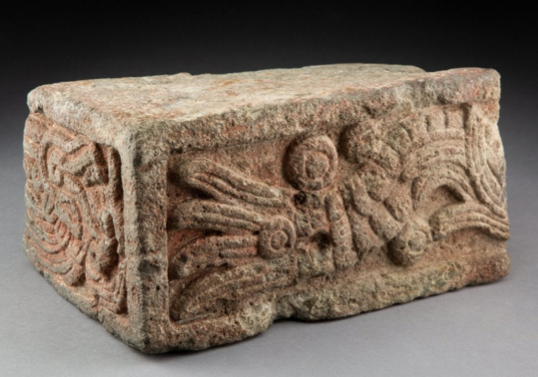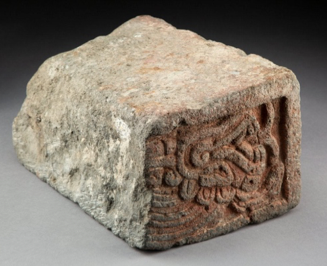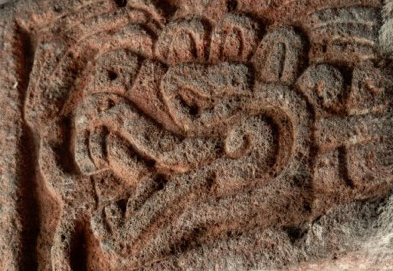Carved stone with feathered serpents

Aztec, Carved stone with feathered serpents, c. 1450-1519, Volcanic stone with red pigment. Museum purchase, John McAndrew Fund 2020.7
View of two carved sides. Note that the sculpture is upside down in this photograph.
Provenance: Earl Stendahl, Los Angeles (before 1960); Alfred Stendahl, Los Angeles, by descent (1966); H. B. Nicholson, Los Angeles, late 1960s; Bruce A. Nicholson, by descent (2007); “American Indian, Pre-Columbian & Tribal Art,” Heritage Auctions, Dallas, December 6, 2019, lot 187.
The Davis Musuem recently acquired a carved Aztec block at auction. The Davis has stopped actively collecting in the field of pre-Columbian (pre-Conquest) arts from the Americas, because of ethical and legal restrictions on acquiring national patrimony or cultural property. The very specific and unique provenance of this particular object, which indicates it was in the US before 1960 and known to scholars, allowed the museum to make an exception. Indeed, it was important to ensure that the work would enter a collection accessible to the public. While the Aztec (or Mexica) are perhaps the most famous of all pre-Columbian civilizations, Aztec stone sculpture is rare in Boston area collections, and the only significant Aztec object at the Davis, the seated Corn Goddess, was purchased in 1998. This new sculpture will not only play an important role in teaching, but will also deeply enrich the collection of works from the ancient Americas.
The block is carved on two sides: on the short side is the head of a fanged serpent in profile, with a crest of feathers and a forked tongue that terminates in a flower. The long side shows the undulating body of the serpent, with longer feathers, a rattle tail, and terminal feathers decorated with three circles (chalchihuites, or jade disks) that indicate preciousness.
It is likely that the block was originally part of the corner of a brightly painted carved bench used for seating in important ritual or ceremonial structures, indicated in the extensive traces of red pigment on the stone.
The rough sides of the block and evidence of breakage are also of historic interest. The condition may be partly due to the fact that the blocks were never completely finished, as they were originally meant to be set into a matrix. But it is also probable that this particular block was reshaped in the early colonial period for use in a Spanish construction program. If so, when first found or collected, most likely in the 20th century, the block was not removed from its original context, but rather was already part of a post-Conquest wall or structure. This gives the block an additional story of use beyond its Aztec origins, and would mean that the initial archaeological destruction or looting took place in or after the 16th century.

Short side of block, with serpent head

Correct orientation, with head facing to left.